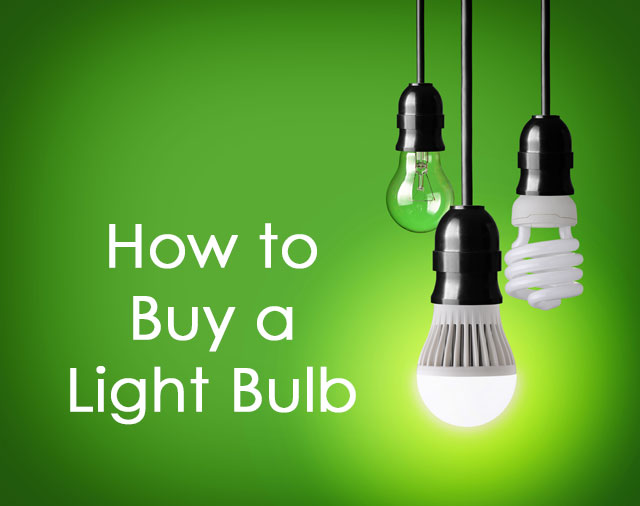
The types of light bulbs you can buy are about to change—again. In 2020, we'll be hitting the second phase of the Energy Independence and Security Act of 2007, which requires light bulbs be more efficient than ever. In 2012, the law started taking old—and much beloved—incandescent bulbs off the shelves in favor of low-energy halogen, compact fluorescent, and LED bulbs.
These efficiency standards don't apply to all bulbs: only what the Department of Energy calls "general service lamps" are subject to these requirements, which covers the average household bulb that fits into your lamps and lighting fixtures. However, there are a lot of lights it doesn't cover, including appliance lamps, rough service bulbs, 3-way bulbs, colored lamps, stage lighting, plant lights, candelabra lights under 60 watts, and outdoor post lights less than 100 watts. That means there are a lot of older bulbs—yes, even classic incandescents—that will still be available on store shelves.
But even with those exceptions, store shelves will look different in a few years as LED bulbs are the only ones that meet the 2020 efficiency standards. Still, we wouldn't call this change reason to panic: LEDs have dropped dramatically in price since 2012, last longer than any other bulb, offer a wide variety of color options, come in traditional light bulb shape, and even have high-tech "smart" options. With all of these features, we expect the compact fluorescent to vanish, completely unmourned.
What are my light bulb options?
Though your lighting options are about to change, currently you'll still find three types of bulbs on store shelves:
- Energy-saving incandescents (halogen): These lower wattage incandescent bulbs have a tungsten filament like standard bulbs, but are surrounded by a halogen gas, rather than argon or nitrogen, which provides bright light with better efficiency. These are 25% more efficient than traditional incandescent bulbs and will last three times as long. Prices start at just under $2 per bulb (60 watt equivalent) on Amazon.
- Compact fluorescents (CFLs): You've probably seen—and maybe hated—these curly, bulb-sized fluorescents. Though early versions tended to offer harsh light, the latest CFL bulbs have more color options and some are even styled to look like traditional incandescent bulbs. These bulbs offer 75% energy savings over an incandescent and last ten times as long. Prices start around $2.50 per bulb (60 watt equivalent) on Amazon.
- LEDs: The most efficient option, LED bulbs are 75-80% more efficient than traditional incandescents and last 25 times longer—and, yes, starting in 2020 these will be the only bulbs that meet federal energy efficiency requirements. Prices start at just over $3 per bulb (60 watt equivalent) on Amazon.
- Smart bulbs: Smart bulbs are LED bulbs that can connect to Wi-Fi so you can control them from your computer or a smartphone app. While the functionality is a bit different for each bulb, you can typically tell them to turn on or off at different times and turn them on or off from afar. Some bulbs will even have the option to control the light color. Prices start at just under $15 per bulb (60 watt equivalent) on Amazon.
What do I need to know about buying a new light bulb?
If you're looking to replace specific bulbs in your household, you're probably used to picking up a bulb that's 60-watt, 75-watt, or the like. Unfortunately these measurements, based on how much energy the bulb used, are not an accurate way to tell how much light bulbs produce—and looking at wattage on new bulbs, which use far less energy, won't get you the right amount of light.
To accurately gauge light level, look for the number of lumens—a measure of how much light a bulb produces rather than how much energy it uses—listed on the package. If you're replacing a specific bulb, here's a cheat sheet:
- If you used to buy 100 watt bulbs, look for a bulb with 1600 lumens.
- If you used to buy 75 watt bulbs, look for a bulb with 1100 lumens.
- If you used to buy 60 watt bulbs, look for a bulb with 800 lumens.
- If you used to buy 40 watt bulbs, look for a bulb with 450 lumens.
It's also important to get a light with the right color temperature—especially with CFLs, which can produce a harsh light. You may find LED lights that can, with one bulb, change their color ranges or even produce multiple colors of light. These may be of interest as different color variants may work better for specific tasks—for example, you might want a bright white light while reading but typically prefer a warmer light.
Color is measured in Kelvins, ranging from 2,700 K (the warm light of typical incadescents) up to around 5,500 K (proving a daylight or natural tone). Though all of these bulbs produce white light, warmer lights will have a more yellow tint—better for bedrooms and other soft lighting conditions—while cooler lights will have a blue tint—better for reading. Check the packaging to see what kind of light a bulb produces before you buy—and if you're not sure what colors you want, go to your local hardware store where you should be able to see different lights on display.
How much will I save with the new light bulbs?
When you're buying new bulbs—no matter the type—you'll want to look for the Energy Star label. Energy Star certified light bulbs are tested to meet energy efficiency standards and will include labeling to tell you exactly what you're buying. The Energy Star label will show the bulb's brightness, color, lifespan, energy usage, and what it will cost to run it for a year. This information makes it easy to compare bulbs, especially if you're considering bulbs of different types.
Let's take a look at just what each type of bulb will cost you, estimating 3 hours of use per day at $0.11 per kilowatt hour.
| Bulb Type |
Energy-efficient incandescent (Halogen) |
Compact fluorescent | LED | Smart bulb (LED) |
| Bulb cost | $2.00/ea | $2.50/ea | $3.00/ea | $15.00/ea |
| Energy use | $5.42/yr | $1.69/yr | $1.00/yr | $1.00/yr |
| Lifespan | 2 - 3 years | 4 - 8 years | 20 years | 20 years |
As you can see, with the falling price of LED bulbs it makes less sense to bother buying older, less efficient bulbs. Even with a higher up-front price, the energy savings over the life of the bulb can be substantial.
LEDs herald the rise of smart lights
While smart lights are still pricier than any other type of bulb, they offer new features for your smart home. Smart lights can be controlled from anywhere, which can be a fun gimmick but can also save you a bit of cash when you set your lights to turn off in the daytime—or can turn them off after you leave the house and remember you've left them running.
One note about smart lights: most of them are controlled by some kind of hub, either one specific to the lights or a standard system used by other smart home appliances. Many smart bulbs will only work with one type of hub, so be sure you're buying the right bulb for your home.
If you're not sure where to start with smart bulbs, take a look at Cree Connected 60-watt equivalent. It comes at a budget-friendly $35 price point and works with a variety of different smart home systems, making it one of the easiest to use.
Updated on 2/17/2016
[light bulb image via Shutterstock]
















From Ellen on January 17, 2014 :: 12:25 pm
I can’t find three-way bulbs in the new styles. Will these be available?
Reply
From Larry on January 17, 2014 :: 12:31 pm
I’ve purchased 3-way bulbs CFL and LED bulbs at Lowes.
Reply